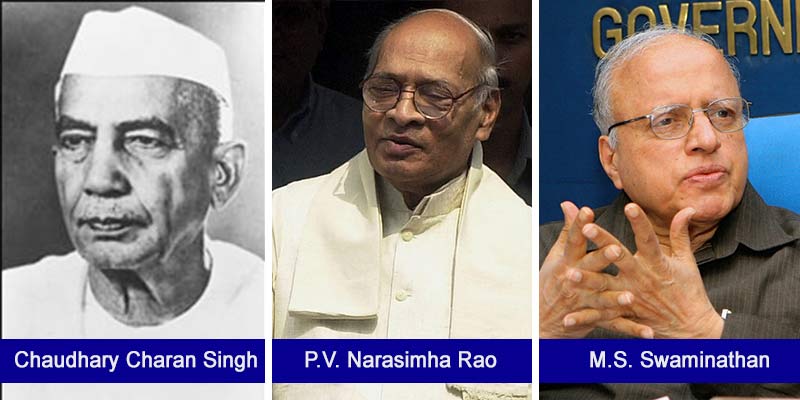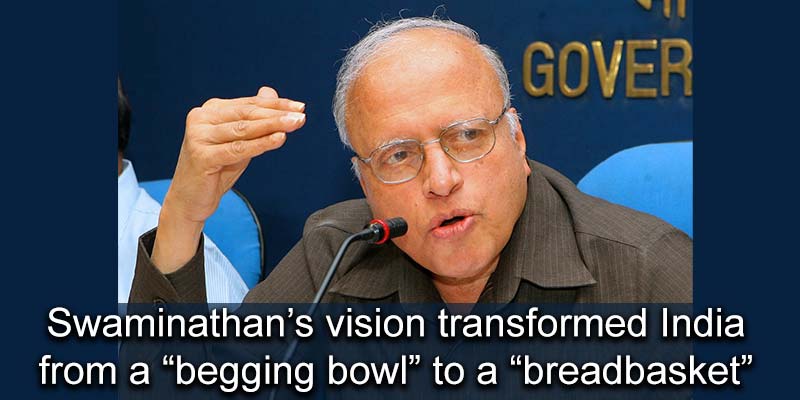- India
- Feb 09
Bharat Ratna for Chaudhary Charan Singh, P.V. Narasimha Rao & M.S. Swaminathan
Former Prime Ministers P.V. Narasimha Rao and Chaudhary Charan Singh as well as Green Revolution pioneer M.S. Swaminathan will be conferred the Bharat Ratna, Prime Minister Narendra Modi announced on February 9.
The government had earlier named former Bihar Chief Minister Karpoori Thakur and BJP leader L.K. Advani for the country’s highest civilian honour.
Who was Chaudhary Charan Singh?
• Chaudhary Charan Singh was born on December 23, 1902 at Noorpur in Meerut district of Uttar Pradesh.
• He graduated in science in 1923, and did his post-graduation from Agra University in 1925. Also trained in law, he set up practice at Ghaziabad. He shifted to Meerut in 1929 and later joined the Congress.
• He was first elected to the Uttar Pradesh Legislative Assembly in 1937 from Chhaprauli, and represented the constituency in 1946, 1952, 1962 and 1967.
• He became Parliamentary Secretary in Pandit Govind Ballabh Pant’s government in 1946.
• Thereafter, between 1951 and 1967, he held various important portfolios under various governments.
• He played a key role in the eradication of the Zamindari system in Uttar Pradesh. It was due to his efforts that the legislation such as the Uttar Pradesh Zamindari and Land Reform Act, 1952, which resulted in the abolition of the system throughout the state.
• As Chief Minister, he was instrumental in bringing about the Land Holding Act, 1960 which was aimed at lowering the ceiling on land holdings to make it uniform throughout the State.
• After the 1967 elections, Charan Singh, accompanied by 16 of his followers, quit the Congress and set up a group called the Jan Congress. Later, the entire opposition came together to form the Samyukta Vidhayak Dal (SVD), including the Jan Congress with Charan Singh as its leader.
• On April 3, 1967, he became the first non-Congress chief minister of Uttar Pradesh from April 3, 1967 to February 25, 1968.
• In February 1970, he became the CM of the state for the second time. However, President’s Rule was imposed in the State on October 2, 1970.
• In 1974, Charan Singh attempted to unite all opposition parties at the national level and formed the Bharatiya Lok Dal (BLD). He was one of the main architects in the formation of the Janata Party at the national level in 1977. He merged the BLD with the Janata Party.
• He was elected to the Lok Sabha in 1977. Charan Singh became the Union Home Minister and was subsequently elevated to the post of deputy Prime Minister. He became the Union Finance Minister in January 1979.
• He resigned from the Janata Party in July 1979 and revived Bharatiya Kranti Dal with a new name Lok Dal.
• Following the resignation of Prime Minister Morarji Desai in July 1979, he was sworn in as the PM.
• Just before he was to prove his majority in Lok Sabha, the Congress withdrew support to Charan Singh’s government, and after just 23 days in power, he resigned.
• He was the only Prime Minister of India who did not face the Parliament.
• He was the author of several books, including ‘Abolition of Zamindari’, ‘Co-operative Farming X-rayed’, ‘India’s Poverty and its Solution’, ‘Peasant Proprietorship or Land to the Workers’ and ‘Prevention of Division of Holdings Below a Certain Minimum’.
• Charan Singh passed away on May 29, 1987.
Who was P.V. Narasimha Rao?
• P.V. Narasimha Rao served as Prime Minister for a single term from 1991 to 1996. During his tenure, he carried out economic reforms in the form of liberalisation and globalisation.
• He was born on June 28, 1921 at Karimnagar. He studied in Osmania University, Hyderabad, Bombay University and Nagpur University.
• He was elected as an MLA for the first time in 1957. Till 1971, he assumed many ministerial positions in the state government. He became the Chief Minister of Andhra Pradesh in 1971.
• He was the Union Minister for External Affairs from January 14, 1980 to July 18, 1984, Union Home Minister from July 19, 1984 to December 31, 1984 and Defence Minister from December 31, 1984 to September 25, 1985. He then assumed charge as Minister of Human Resource Development on September 25, 1985.
• He was sworn in as the Prime Minister on June 21, 1991.
• Rao was the first person from south India to become the PM.
• When the country was facing a foreign reserves crisis, Rao’s government brought big-ticket economic reforms — globalisation, liberalisation and privatisation.
• He is widely recognised for ushering in economic reforms.
• India’s Look East policy was enunciated by him in 1992.
• In 1992, his government passed the Constitution 73rd and 74th Amendment Acts, which mandated reservation of one-third of seats for women in Panchayati Raj institutions.
• Rao passed away in December 2004.
Who was M.S. Swaminathan?
• He was born on August 7, 1925 in Kumbakonam, Tamil Nadu.
• A plant geneticist by training, Swaminathan has made a stellar contribution to the agricultural renaissance of India.
• As a young scientist at the Indian Agricultural Research Institute in the 1950s, Swaminathan learned of Dr. Norman Borlaug’s newly developed Mexican dwarf wheat variety and invited him to India.
• These two world‐renowned agricultural scientists met for the first time in 1953 at a conference organised by the American Society of Biological Sciences hosted by the University of Wisconsin‐Madison. Dr. Swaminathan was most intrigued with Borlaug’s presentation about a new method of controlling rust disease in wheat.
• Swaminathan worked closely with Borlaug to bring about the great agricultural transformation. Together they spread high-yielding wheat and rice varieties and improved agricultural practices among the poorest farmers of India.
• Indian consumers did not care for the red colour of the Mexican wheat varieties like ‘Lerma rojo’ for making chapati bread, and so Borlaug provided seeds from his work in Pakistan that were more amber in colour. Swaminathan conducted additional research on these varieties to develop ‘Sonalika’ and ‘Kalyan Sona’, which had the desired chapati‐making quality.
• Swaminathan also created new methods to teach Indian farmers how to effectively increase production by employing a combination of the high-yielding wheat varieties, fertilisers, and more efficient farming techniques.
• Swaminathan set up thousands of demonstration and test plots. The first year’s harvest tripled previous production levels.
• His direct work with farmers overcame the obstacles of illiteracy and lack of formal education and provided a generation of Indians with knowledge about the effectiveness of modern agriculture.
• Through the application of science, education of farmers, famine was averted, and, by the late 1960s, Indian agriculture was on course to self‐sufficiency in cereal grains.
• Swaminathan’s vision transformed India from a “begging bowl” to a “breadbasket”.
• Swaminathan passed away on September 28, 2023 at the age of 98.
Manorama Yearbook app is now available on Google Play Store and iOS App Store


